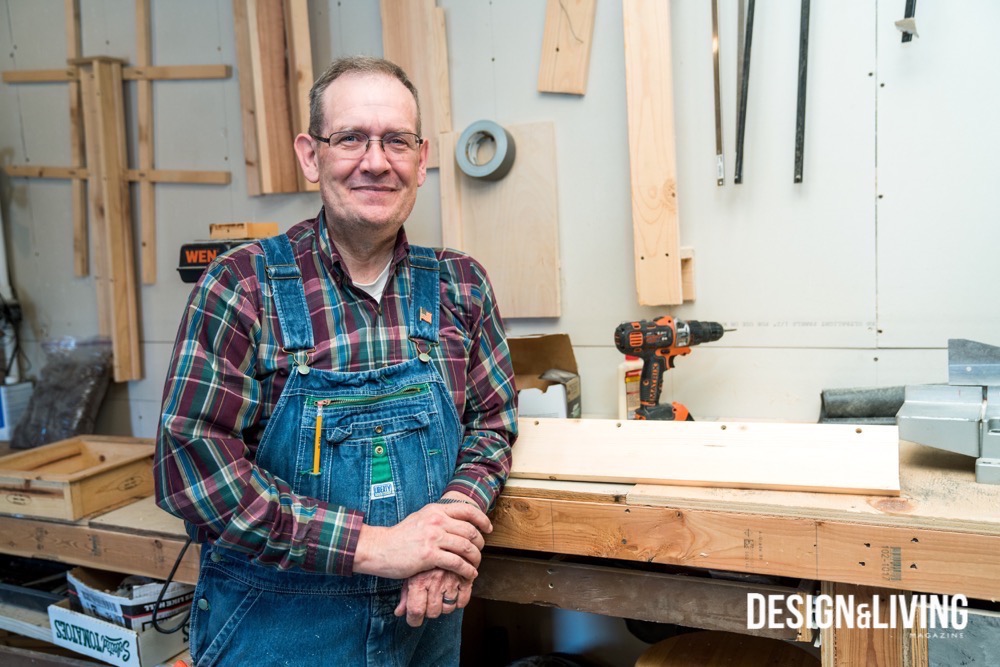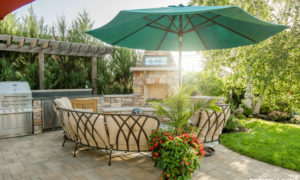Photos by Hillary Ehlen and Brian Fuder
If you asked your child or grandchild to draw you a farmer, you might get something that looks like Brian Fuder, wearing his signature denim overalls and plaid shirt. Fuder is the only certified Square Foot Gardening instructor in North Dakota and upper Minnesota. There may have been snow on the ground when we visited his shop, but Fuder has a warm nature that he gladly shares with anyone who is interested in gardening.
Get to Know Fuder
Originally from Breckenridge, Minnesota, Fuder moved to Fargo with his wife and son to take a job at NDSU. Today, he is the Regional Manager for Donor Development at Dakota Lions Sight and Health and pursues gardening in his spare time.
Fuder has been playing around with Square Foot Gardening for a number of years. Eventually, people started asking him to teach them how to do it. He soon got ahold of the foundation and sought certification. Square Foot Gardening is typically taught on the ground, but Fuder elevated the wooden planters for accessibility. “People have no trouble getting down on the ground. It’s getting back up that is the problem,” Fuder joked.

Fuder uses one-foot-by-one-foot models to demonstrate how Square Foot Gardening works. “In one square foot, depending on the plant size, we can either plant one, four, nine or 16 plants in each of those square feet. If you were going to plant radishes, you could plant 16 radishes in here,” Fuder said.
The Square Foot Gardening Method
“People get excited around this time of year. They want to start gardening, so they get outside, dig up half of their backyard and get this huge garden that’s just way too much work. By the Fourth of July, its full of weeds and half dead and they say, ‘I’m never going to garden again.’ Square foot gardening is a method that we use to decrease the overall size of the garden,” Fuder said.

Square Foot Gardening is a grid-based gardening method that was created by Mel Bartholomew in 1976. Fuder first became aware of Bartholomew by watching his PBS series that aired from 1982-1986. “I used to think that this guy had the coolest job in the world,” Fuder said.

When making the Square Foot Gardens, Fuder trims each piece of wood to size. “A lot of times your lumber will vary in width from three eighths of an inch from one piece to another. I trim everything to size,” he explained.
Fuder’s Workshop
Fuder builds all of his own elevated planters in a shop in his backyard. Though he is more than happy to accept custom orders, Fuder builds three-foot-by-three-foot wooden boxes that are elevated about three feet off of the ground, making them wheel-chair-accessible. Usually, Fuder’s Square Foot Gardens weigh about 40 pounds, making them sturdy enough to withstand North Dakota winds.

Fuder builds each of the planters by hand. “I’m pretty fussy about how they go together. I put a little extra love and attention into each and every one of them,” he said. Fuder sells his three-foot-by-three-foot gardens for $149, but custom orders vary. Fuder explained how he has determined the price tag for his labor of love. “I’ve got it down to materials and time. My biggest dream is that someone is going to come in and ask for 100 of them, and my biggest fear is that someone is going to come in and ask for 100 of them,” he said with a laugh. Luckily, he does have a gentleman who is willing to help when he does have a larger workload.
“Square foot gardening is a method that we use to decrease the overall size of the garden.”- Brian Fuder
Giving Back Through Square Foot Gardening
Fuder loves to share his work and believes that gardening can be therapeutic for people of all ages. He recently built Square Foot Gardens that he will donate to the Moorhead Head Start program thanks to a grant from The Awesome Foundation. He also built a Square Foot Garden for a pair of blind, elderly sisters who placed Braille labels on the wooden planter to keep track of where each vegetable had been planted. Fuder is also responsible for bringing Square Foot Gardening to Daily Park in Moorhead and has a large set of gardens where he teaches classes at Trollwood Park in North Fargo.



Fuder’s Tips for Square Foot Gardening
- Place the Square Foot Garden in a sunny location, away from trees, close to the house.
“If you tuck it into the back corner of your yard, it’s easy to ignore it,” Fuder said. - Plant some of the things that you usually buy when you go to the grocery store.
- Spend a little time each day tending your Square Foot Garden.

“It’s probably three minutes of care a day,” said Fuder.
The Secret to Square Foot Gardening
“We can plant in succession so that you always have something growing, something harvested and something being planted. In that nine square feet, we could have enough to feed an average adult a fresh salad or vegetable every day of the growing season,” Fuder explained.
Perhaps the most important ingredient of Square Foot Gardening though is the soil that Fuder uses. “We don’t use topsoil. The secret to this is really in this mix. It’s a combination of vermiculite, peat moss and compost. All of the nutrients, everything that we need is there. It’s very light, friable, airy, so you get a good root structure.
There’s more underneath the ground of most plants than there is above ground, so we have to have a good root structure. Roots have to be able to breath. With this type of a mixture, your roots are able to breath. It allows for drainage and it also allows for some moisture retention. We don’t have to put any inorganic fertilizers in there. We just put another scoop of peat or another scoop of compost in and we’ve got a good healthy garden,” Fuder said.
Brian Fuder
3902 6th St. S, Moorhead
701-640-8985
[email protected]
sfgrrv.com
gofundme.com/SFGRRV
facebook.com/SFGRRValley












